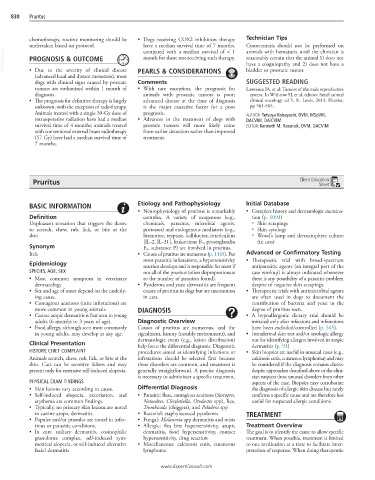Page 1647 - Cote clinical veterinary advisor dogs and cats 4th
P. 1647
830 Pruritus
chemotherapy, routine monitoring should be • Dogs receiving COX2 inhibition therapy Technician Tips
undertaken based on protocol. have a median survival time of 7 months, Cystocentesis should not be performed on
VetBooks.ir PROGNOSIS & OUTCOME month for those not receiving such therapy. reasonably certain that the animal 1) does not
animals with hematuria until the clinician is
compared with a median survival of < 1
have a coagulopathy and 2) does not have a
• Due to the severity of clinical disease
(advanced local and distant metastasis), most PEARLS & CONSIDERATIONS bladder or prostatic tumor.
dogs with clinical signs caused by prostate Comments SUGGESTED READING
tumors are euthanized within 1 month of • With rare exception, the prognosis for Lawrence JA, et al: Tumors of the male reproductive
diagnosis. animals with prostatic tumors is poor; system. In Withrow SJ, et al, editors: Small animal
• The prognosis for definitive therapy is largely advanced disease at the time of diagnosis clinical oncology, ed 5, St. Louis, 2013, Elsevier,
unknown, with the exception of radiotherapy. is the major causative factor for a poor pp 561-565.
Animals treated with a single 30-Gy dose of prognosis. AUTHOR: Tetsuya Kobayashi, DVM, MSpVM,
intraoperative radiation have had a median • Advances in the treatment of dogs with DACVIM, DAiCVIM
survival time of 4 months; animals treated prostate tumors will more likely come EDITOR: Kenneth M. Rassnick, DVM, DACVIM
with conventional external beam radiotherapy from earlier detection rather than improved
(57 Gy) have had a median survival time of treatment.
7 months.
Pruritus Client Education
Sheet
BASIC INFORMATION Etiology and Pathophysiology Initial Database
• Neurophysiology of pruritus is remarkably • Complete history and dermatologic examina-
Definition complex. A variety of exogenous (e.g., tion (p. 1091)
Unpleasant sensation that triggers the desire chemicals, parasites, microbial agents, ○ Skin scrapings
to scratch, chew, rub, lick, or bite at the proteases) and endogenous mediators (e.g., ○ Skin cytology
skin histamine, tryptase, kallikreins, interleukins ○ Wood’s lamp and dermatophyte culture
[IL-2, IL-31], leukotriene B 4 , prostaglandin (in cats)
Synonym E 2 , substance P) are involved in pruritus.
Itch • Causes of pruritus are numerous (p. 1445). For Advanced or Confirmatory Testing
most parasitic infestations, a hypersensitivity • Therapeutic trial with broad-spectrum
Epidemiology reaction develops and is responsible for most if antiparasitic agents (an integral part of the
SPECIES, AGE, SEX not all of the pruritus (often disproportionate case workup) is always indicated whenever
• Most common symptom in veterinary to the number of parasites found). there is any possibility of a parasitic problem
dermatology • Pyoderma and yeast dermatitis are frequent despite of negative skin scrapings.
• Sex and age of onset depend on the underly- causes of pruritus in dogs but are uncommon • Therapeutic trials with antimicrobial agents
ing cause. in cats. are often used in dogs to document the
• Contagious acarioses (mite infestations) are contribution of bacteria and yeast in the
more common in young animals. DIAGNOSIS degree of pruritus seen.
• Canine atopic dermatitis is first seen in young • A hypoallergenic dietary trial should be
adults (6 months to 3 years of age). Diagnostic Overview initiated only after infections and infestations
• Food allergy, although seen most commonly Causes of pruritus are numerous, and the have been excluded/controlled (p. 345).
in young adults, may develop at any age. signalment, history (notably environment), and • Intradermal skin test and/or serologic allergy
dermatologic exam (e.g., lesion distribution) test for identifying allergen involved in atopic
Clinical Presentation help focus the differential diagnosis. Diagnostic dermatitis (p. 91)
HISTORY, CHIEF COMPLAINT procedures aimed at identifying infections or • Skin biopsies are useful in unusual cases (e.g.,
Animals scratch, chew, rub, lick, or bite at the infestations should be selected first because calcinosis cutis, cutaneous lymphoma) and may
skin. Cats can be secretive lickers and may these disorders are common, and treatment is be considered if the diagnosis remains elusive
present only for extensive self-induced alopecia. generally straightforward. A precise diagnosis despite approaches described above or the clini-
is necessary to administer a specific treatment. cian suspects these unusual disorders from other
PHYSICAL EXAM FINDINGS aspects of the case. Biopsies may corroborate
• Skin lesions vary according to cause. Differential Diagnosis the diagnosis of allergic skin disease but rarely
• Self-induced alopecia, excoriation, and • Parasitic: fleas, contagious acarioses (Sarcoptes, confirms a specific cause and are therefore less
erythema are common findings. Notoedres, Cheyletiella, Otodectes spp), lice, useful for suspected allergic conditions.
• Typically, no primary skin lesions are noted Trombicula (chiggers), and Pelodera spp
in canine atopic dermatitis. • Bacterial: staphylococcal pyoderma TREATMENT
• Papules and/or pustules are noted in infec- • Fungal: Malassezia spp dermatitis and otitis
tious or parasitic conditions. • Allergic: flea bite hypersensitivity, atopic Treatment Overview
• In cats: miliary dermatitis, eosinophilic dermatitis, food hypersensitivity, contact The goal is to identify the cause to allow specific
granuloma complex, self-induced sym- hypersensitivity, drug reaction treatment. When possible, treatment is limited
metrical alopecia, or self-induced ulcerative • Miscellaneous: calcinosis cutis, cutaneous to one medication at a time to facilitate inter-
facial dermatitis lymphoma pretation of response. When doing therapeutic
www.ExpertConsult.com

